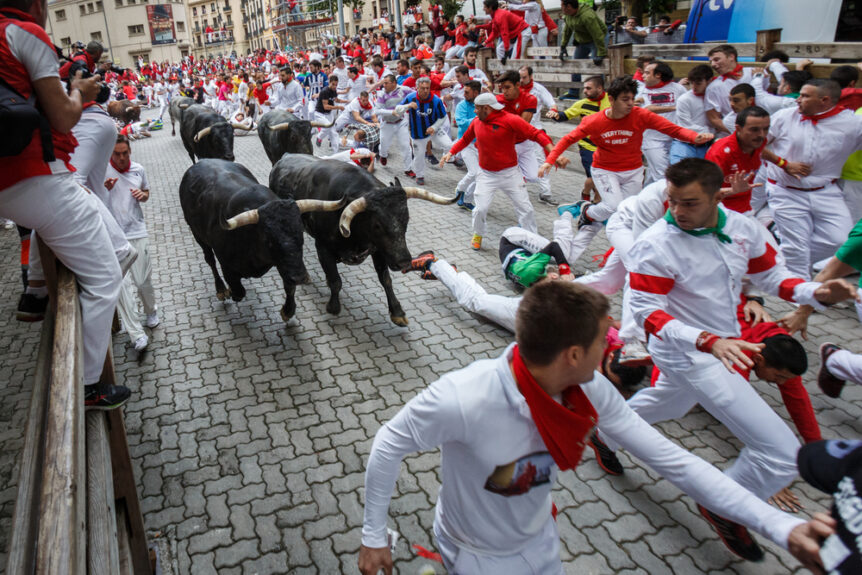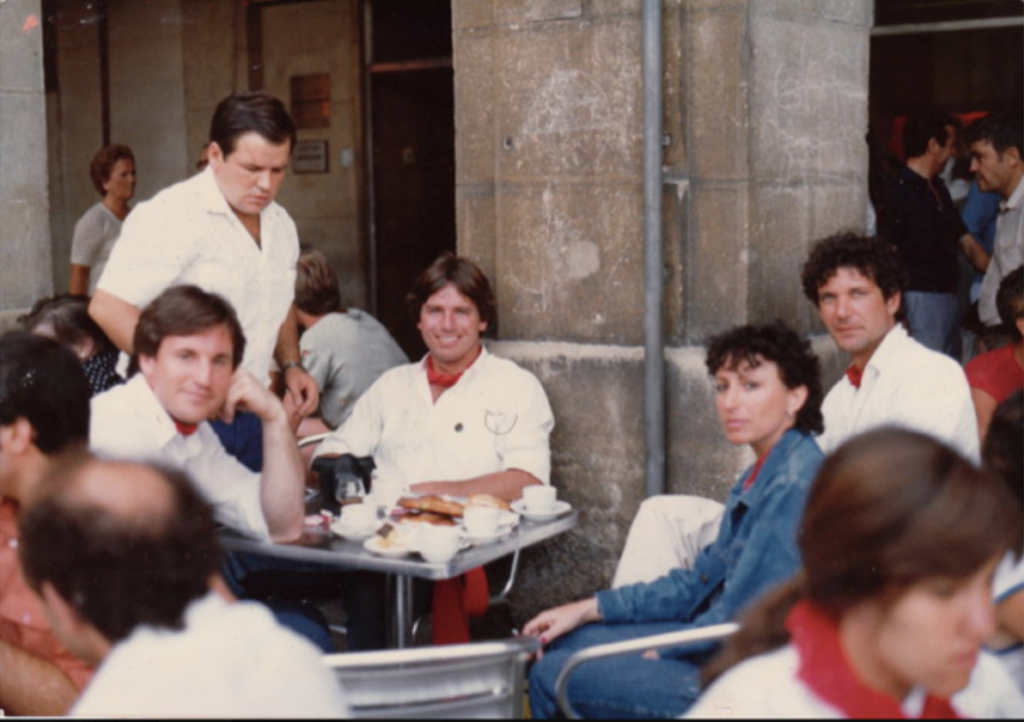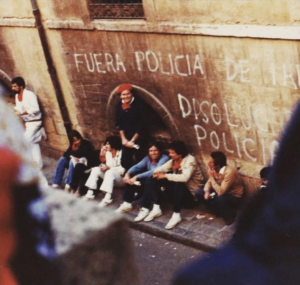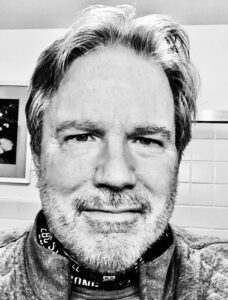
Toros Aqui! La Fiesta de San Fermin
by Michael Ledwith
July 9, 2023
The great writer John Kass, interviewed my best friend Gary Fencik on his podcast The Chicago Way.
They talked about the Fiesta de San Fermin, better known as the running with the bulls in Pamplona, Spain. It runs from July 6 through July 14. Saint Fermin was a Roman who converted to Christianity and was beheaded for his faith.

That’s Gary on the left in the photo above with Wayne Kruer, and his Basque wife Ana Ansa, and me. We’re having breakfast after the run at a café across from the Plaza de Toros.
We’re wearing blood red scarves around our necks, as all the runners do, to honor the martyrdom of San Fermin.
He was an All-Pro safety for the Bears at the time and showed considerable courage by running with a career and a contract on the line.
John and I talked about the interview shortly after it aired and he was fascinated by the story. He asked me if I had ever written about running with the bulls. I answered yes.
I wrote this a couple of days before the festival began in July several years ago.
The Fiesta de San Fermin starts on the seventh hour, of the seventh day, of the seventh month. A rocket goes up and explodes.
The fighting bulls are released from the holding pen near the corral.
Listen to Gary’s tale about the day we ran, and then read this story.
Hopefully, it will inspire you to be in Pamplona one day during the fiesta.
San Fermin
I went to Pamplona because of Ernest Hemingway. Almost everyone who has ever read ‘The Sun Also Rises’ has dreamed of Bret Ashley, the lost generation, and the encierro.
It is the beginning of July and time for the Festival de San Fermin.
You would know it as the running of the bulls in Pamplona.
Generations of Americans have made the trip to see the encierro, to participate in the festival, to drink and dance the night away in the streets, to stand on the battlements of the city wall and watch the sunrise, and, some, to run with the bulls.
Several years ago MTV covered the run in MTV style: excited announcers, over the top color commentators, all dressed in MTV versions of the traditional white and red of Navarre.
They tried to cover it as if it was a Real World knock off by way of Spring Break in an ocean-less Cancun.
But, it was Spain, and it was a bit too real.
Interviews before the run with drunken Americans, mostly college age, followed familiar MTV interview protocols: high fives, knuckle bumps, and f-bomb bleeps while spraying wine from newly bought botas.
Then the cameras strategically placed along the route the bulls and steers ran to the bullring showed the actual encierro as it happened.
The formerly high-spirited runners were interviewed again after they participated.
It was hilarious.
Kind of like interviewing disaster survivors.
Like trying to talk to Confederates after Pickett’s Charge, or people who had just survived a plane crash.
Stunned, incoherent, trembling.
“What do you think?” a cheery announcer would ask a face dulled by absolute fear.
“What do I think? What do I think!!!!!”… life would come back to the thirty year old with the Cubs cap worn backwards and the Umphrey’s McGee t-shirt, realizing that he had survived in body, if not mind.
“What do I think?”, any of the runner interviewed would scream.
Voice strangled, a voice coming from some unknown part of, until ten minutes ago, a comfortable twenty-something life.
A few would actually grab the microphone from the MTVer, and look straight into the camera…
“Don’t come here!” They would cry.
“You can get killed. It’s so scary. Don’t do this!”
Then to the MTV personality, “Do you think this is funny?”
“You have to tell them!” They would shout. “This IS NOT fun!”
Some seemed positively Michael Behn-ish talking about the Terminator.
The interviewer would make frantic cutting motions across his throat to the producer.
After a few years, they gave up.
I went to Pamplona because of Ernest Hemingway.
Almost every teenage male who has read ‘The Sun Also Rises’ has dreamed of Bret Ashley, the lost generation, and the encierro.
The first time I was ever in Spain, I took a slow train from San Sebastian to Pamplona. Arriving at the train station it was as if I was in Paris the day before the Nazis arrived.
Hundreds of what seemed to be refugees lying about the grounds of the station waiting for the next train.
Crowding every departing train, fighting for space.
It was the third day of the festival, and some had had enough.
I spent the day drinking in bars and eating pintxos. Rollicking with Australians and Germans and Argentines. I threw my backpack and sleeping bag under a tree near a river close to the bullring and went into the old city.
At night it was a combination of Mardi Gras and New Year’s Eve.
Bands parading, playing as loudly as possible. Surging throngs of Basques in all white with red neckerchiefs, talking and laughing and hugging everyone they came across.
Restaurants packed and so noisy with merriment that you could shout to the person next to you and not be heard.
This went on all night.
At dawn it was traditional to go to the city’s walls and watch the sunrise.
Then those who would run began clustering in the streets for the encierro.
In later years I would discover that there were traditions and traditional parts of the run that demanded certain behaviors. But, this first time, I stood with a mass of young men and waited for the bulls.
A rocket went off and some began running immediately for the bullring. Others waited.
For what I wondered?
Soon a crowd surged toward us, thickened, filling the narrow street. Fear became palpable. Panic.
Someone grabbed me and yelled let’s go.
As I turned to run, a glut of runners crying ‘toros aqui’ trampled everything in their path.
I was hit as if by a blocking guard, and almost went down. I looked back.
For the first time in my life saw a fighting bull. Not a cow, or the bull in your uncle’s pasture, but a Spanish fighting bull. Bulls from special ranches. Bred for centuries to fight and die in the ring.
Bulls with sharp wide horns. A moving wall of muscle.
If separated from the oxen, deadly.
My protection was a rolled up Diario de Navarra, the local newspaper.
I had been told the night before that if I was ever in danger of death from the horns to wave the Dario in front of the bull’s eyes. Depending on the news of the day, the headlines might be interesting enough for him to be distracted from goring me by reading the lead story.
The bull nearest me as I ran snorted at the news of a new water tax, and his horn missed me by a column inch.
It was the first and last time that reading a book almost got me killed.
Hemingway wrote of bull fighting in Death in the Afternoon in a way that almost makes you forget the cruelty.
He wrote of the running of the bulls in Pamplona in The Sun Also Rises in a way that encourages you to find a way some July to stand in Santo Domingo in white pants, a white shirt, a red neckerchief.
To wait for the bulls with that morning’s Diario rolled in your hand. With that Spanish commitment to courage in the face of death. Waiting of your own free will, for that moment that can change your life. Waiting for the rocket to go off.
MTV won’t save you. The new BMW means nothing. Cutting the handicap from a twelve to ten, means nothing.
You’ll never feel so alive at eight o’clock of a July morning, being close to the horns.
 On Santo Domingo waiting for the first rocket to go off. My brother in the red beret. Me in the blue sweater. Wayne Kruer our friend and guide talking to me about not going into the tunnel at the bullring. The holding pen for the fighting bulls is sixty yards down the street to our right. The tradition, in that part of the run, is not to start to run until the last bull has exited the holding pen. We waited after the first rocket signaling the gate opening, watching the bulls lumber toward us, for the second rocket indicating the last bull left the pen. A 17 year-old was gored to death sixty yards up the street to our left. A rogue bull, Antioquio, separated from the group of oxen, killed two and gored fourteen on his way to the bullring.
On Santo Domingo waiting for the first rocket to go off. My brother in the red beret. Me in the blue sweater. Wayne Kruer our friend and guide talking to me about not going into the tunnel at the bullring. The holding pen for the fighting bulls is sixty yards down the street to our right. The tradition, in that part of the run, is not to start to run until the last bull has exited the holding pen. We waited after the first rocket signaling the gate opening, watching the bulls lumber toward us, for the second rocket indicating the last bull left the pen. A 17 year-old was gored to death sixty yards up the street to our left. A rogue bull, Antioquio, separated from the group of oxen, killed two and gored fourteen on his way to the bullring.
It was the bloodiest encierro in the history of San Fermin.
When he entered the bullring to fight that afternoon, the crowd chanted asesino, asesino!
Murderer! Murderer! In Spanish.
He became so famous an artist drew his portrait.

-30-
 Frequent contributor Michael Ledwith is a former bag boy at Winn-Dixie, who worked on the Apollo Program one summer in college. A former U.S. Army officer, he ran with the bulls in Pamplona and saw Baryshnikov dance ’Giselle’ at the Auditorium Theater. Surfer. Rock and roll radio in Chicago. Shareholder, Christopher’s American Grill, London. Father. Movie lover—favorite dialogue: “I say he never loved the emperor.”
Frequent contributor Michael Ledwith is a former bag boy at Winn-Dixie, who worked on the Apollo Program one summer in college. A former U.S. Army officer, he ran with the bulls in Pamplona and saw Baryshnikov dance ’Giselle’ at the Auditorium Theater. Surfer. Rock and roll radio in Chicago. Shareholder, Christopher’s American Grill, London. Father. Movie lover—favorite dialogue: “I say he never loved the emperor.”


Comments 7
Michael,
Every time you publish something here, my only response is: “More, please”.
Good stuff.
HY
yes. bravo michael
How fun!!
And here, I always thought that “encierro” was something you get at Taco Bell. Silly me…
Yawn.
Michael….. you can write my friend. Excellent piece!
Very nice…